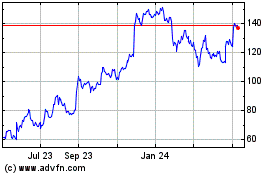Pinduoduo says conditions are ripe to reimagine logistics
May 26 2021 - 6:38AM

When Pinduoduo was started in 2015, the founding team faced an
important decision. Should the e-commerce startup concentrate its
resources to develop a mobile-only platform, or spread its bets and
also create a desktop version, given most online shopping still
took place on personal computers and laptops?
At that time, there were good arguments both ways, but Chen Lei,
who oversaw technology development at Pinduoduo, won the day. He
persuaded the team to focus exclusively on developing a mobile
architecture, confident that the proliferation of cheap smartphones
and increasing broadband speeds would unleash wholesale changes in
consumer behavior. He wanted Pinduoduo to be at the front of the
line to catch this once-in-a-generation wave. It turned out to be
the right decision as consumers embraced the new interactive
e-commerce that Pinduoduo espoused. As of the end of March,
Pinduoduo surpassed 800 million annual active buyers, cementing its
position as the most widely used e-commerce platform in China, less
than six years since its founding. The company has been credited
with pioneering a widely emulated model of interactive e-commerce
that has remade supply chains and given birth to more
direct-to-consumer brands. Chen himself has taken over as Chairman
and CEO of the company, as founder Colin Huang stepped down to
focus on his passion for life sciences. “Ten years ago, I felt
certain that human behavior would definitely change with the
ability to interact with friends and family in real-time, and so it
was with the rise of the mobile internet,” said Chen. “Everything
became more on-demand, more personalized, and this personalization
is being informed by interaction. Our starting point for building
our underlying architecture was how to facilitate this interaction,
whether it’s between friends, or with the platform.”
In China, hundreds of millions of consumers owned computers for
the very first time, and they were computers that could fit the
pockets. The innovation of the mini-program further meant that
consumers with more basic handsets could also participate in the
new interactive era. The smartphone not only freed consumers from
their desks, but also fundamentally changed the way people accessed
the internet and created entirely new uses, according to Chen.
In e-commerce, this transformed the way people bought things,
from proactively searching for items to purchase, to browsing for
fun and leisure during pockets of free time throughout the day. The
rise of social networking added an extra dimension to the mix as
one’s social circles also influenced online purchase decisions,
just as they did in the physical domain.“Pinduoduo found room in
e-commerce, not as a competitor to search-based websites, but as a
new e-commerce platform focused on interactive and social shopping
experiences online,” wrote Anu Hariharan and Nic Dardenne of Y
Combinator. “Social shopping may seem like a new concept, but the
reality is that in the physical world, shopping is meant to be
‘interactive and fun’ and purchases are regularly informed by
friends and family.”As Pinduoduo continues to attract more users
with its brand of offering “more savings” and “more fun”, Chen Lei
is casting his eyes on what he believes will be another wave of
innovation: logistics. With the increasing level of digitization of
logistics, more real-time information is now available to offer
insights into various parts of the process of transporting parcels
from manufacturer to consumer, according to Chen. Yet, the
logistics infrastructure in China was basically set up and built
out in an era before real-time information was readily available.
Crucially, computing power has advanced in the past decade to the
point where making sense of the tidal wave of information is now
possible. That has laid the foundations upon which to build a more
responsive and adaptive system of moving goods and merchandise,
Chen said.“If you think about it, we have a hub-and-spoke system
that was created over the past decade to concentrate parcel flows
into centralized hubs, which was the right thing to do 10 years ago
because China is just too large a country and the e-commerce order
volume was still low,” said Chen. “But what about 10 years from
now? The future of logistics should not be burdened by legacy
considerations that have already changed.”With rising parcel
volumes, it is now possible to develop a more flexible logistics
infosystem and agriculture-focused infrastructure that reduces the
need for multiple transshipments and enables more point-to-point
deliveries. This can be achieved through the use of advanced
calculations that take into consideration multiple factors such as
the timing of truck deliveries, warehouse location, route planning,
he said.And much like the smartphone and broadband heralded the
mobile era, Chen believes that fast-maturing technologies like
automated vehicles and robots, and advanced computing, could usher
in a new age for logistics. Creating such a system would require a
brand-new technology architecture, he said.“Personally, it’s an
extremely interesting topic and I’ll be spending a lot of time
studying it,” said Chen, who has a PhD in computer science and was
a gold-medal winner in the Informatics Olympiad in his teens. “We
should make use of our own comparative advantages and raise the
operational efficiency of society. This will also reduce
unnecessary harm to nature at the same time.”
About Pinduoduo Inc.Pinduoduo is a mobile-only
marketplace that connects millions of agricultural producers with
consumers across China. Pinduoduo aims to bring more businesses and
people into the digital economy so that local communities can
benefit from the increased productivity and convenience through new
market opportunities.For more information on Pinduoduo news and
industry trends, please visit the content hub
at https://stories.pinduoduo-global.com/.
For media inquiries, please contact:
Pinduoduo Inc.
internationalmedia@pinduoduo.com
PDD (NASDAQ:PDD)
Historical Stock Chart
From Mar 2024 to Apr 2024

PDD (NASDAQ:PDD)
Historical Stock Chart
From Apr 2023 to Apr 2024
